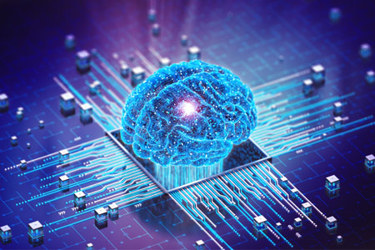Neuromorphic Computing Breakthrough Could Be A Game-Changer

By John Oncea, Editor

Neuromorphic computing uses principles from neuroscience to create devices that mimic neural systems, achieving efficient brain-like processing. It combines photonics and neuromorphic architectures for high efficiency and connectivity.
Late last year, a group of scientists and students led by Professor Sreetosh Goswami at the Centre for Nano Science and Engineering (CeNSe), Indian Institute of Science (IISc), announced in the journal Nature a breakthrough in neuromorphic computing technology that could move the integration of artificial intelligence (AI) away from the cloud and toward the edge and personal devices, laptops, or mobile phones.
The breakthrough not only has the potential to change AI computing, it “could potentially allow India to play in the global AI race currently underway,” writes the Decan Herald.
What Is Neuromorphic Computing?
Neuromorphic photonics is an interdisciplinary field that combines ideas from neuroscience, computer engineering, and photonics. The goal is to build computing systems that mimic how the human brain processes information, but instead of using electrical signals (like traditional computers), these systems use light.
“Using optics and photonics principles, neuromorphic devices can execute intricate computations swiftly and with impressive energy efficiency,” writes MDPI. “This innovation holds promise for advancing artificial intelligence and machine learning while addressing the limitations of traditional silicon-based computing.”
The use of light instead of electricity offers several advantages, starting with faster speed as light travels much faster than electrical signals in wires. Photonic systems improve bandwidth by carrying more data at once and are theoretically more energy efficient, capable of processing information with less heat and energy loss than electronics.
In neuromorphic photonics, optical components (like lasers, modulators, and detectors) play the role of neurons and synapses. Data is encoded in light pulses, which interact in ways that mimic the computations in biological neural networks. Like the brain, these systems can process many signals at the same time, enabling efficient parallel computation.
According to MDPI, “Neuromorphic photonics could herald a new era of computing that is more potent and draws inspiration from cognitive processes, leading to advancements in robotics, pattern recognition, and advanced data processing.” Other benefits include:
- AI Acceleration: Neuromorphic photonic chips could dramatically speed up machine learning and AI tasks, especially those involving large neural networks.
- Scalability: Photonic systems could handle much larger networks than traditional silicon chips.
- New Possibilities: This technology could lead to breakthroughs in areas like robotics, autonomous vehicles, and real-time data analysis.
Neuromorphic photonics is about building brain-like computers that use light instead of electricity to process information. This approach promises to make computing much faster and more energy-efficient, especially for AI and complex data tasks.
IISc’s Neuromorphic Computing Breakthrough
Last September’s neuromorphic computing breakthrough made by the IISc team introduced a brain-inspired analog computing platform capable of storing and processing data in 16,500 distinct conductance states within a molecular film – a radical departure from traditional binary systems limited to two states (0s and 1s).
This innovation, writes YourStory, promises to transform AI hardware, enabling complex tasks like training large language models (LLMs) on personal devices while drastically reducing energy consumption.
The IISC team developed a molecular memristor, a semiconductor device using a metal-organic film instead of conventional silicon. This material leverages the natural movement of ions and molecules to mimic the brain’s neural networks, where memory and processing occur simultaneously, notes the Declan Herald. Key advancements include:
- Analog Processing: Unlike digital computers, which separate data storage and processing, the memristor integrates both functions, akin to biological synapses.
- Matrix Multiplication Efficiency: The platform reduces 64x64 matrix multiplication – a core AI operation – to 64 steps, compared to 262,144 operations in digital systems.
- Precision Engineering: A custom circuit board was designed to measure voltages as small as one-millionth of a volt at high speeds, ensuring accurate tracking of molecular states.
To showcase their platform’s capabilities, the team recreated NASA’s iconic Pillars of Creation image using data from the James Webb Space Telescope. Their system completed this task on a tabletop computer in a fraction of the time and energy required by traditional supercomputers.
This demonstration highlights the technology’s potential for edge computing by shifting AI training from energy-intensive data centers to personal devices like laptops and smartphones. In addition, the memristor’s analog design consumes far less power than silicon-based digital processors, addressing a critical bottleneck in AI development.
Finally, the team achieved improved scalability and has already integrated a 64x64 memristor array with a 65nm silicon processor, paving the way for larger arrays (e.g., 256x256) and eventual system-on-chip solutions.
Collaboration And Future Goals
The breakthrough was achieved through a collaboration between IISc, Texas A&M University, and the University of Limerick, with IISc leading the material and hardware development. Supported by India’s Ministry of Electronics and Information Technology (MeitY), the team aims to commercialize the technology via startups and position India as a leader in next-gen AI hardware, writes Tech Xplore.
According to IISc, this innovation addresses two major challenges in AI: hardware limitations and the democratization of AI. Goswami emphasized the significance, saying, “With this discovery, we have almost nailed the perfect system – a rare feat.”
